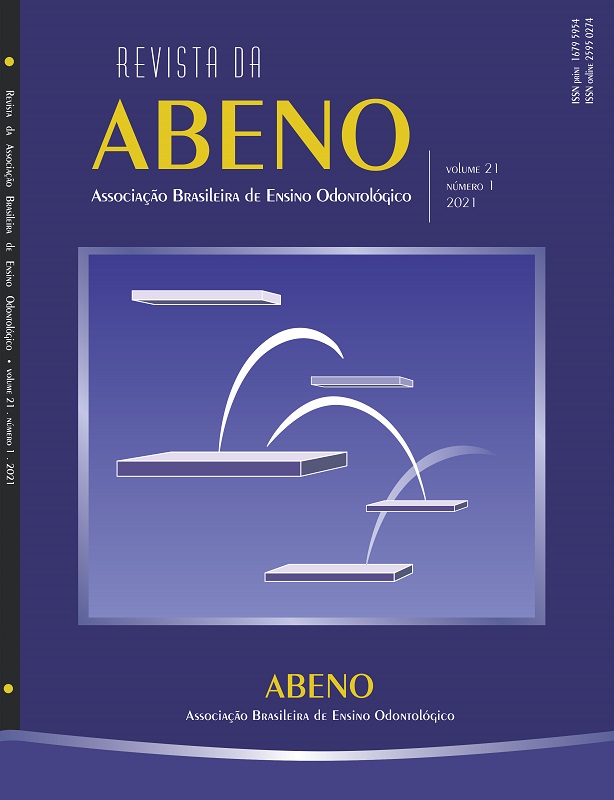Experience report in teaching Dentistry based on active teaching-learning methodologies
gamification and ludic practices
DOI:
https://doi.org/10.30979/revabeno.v21i1.1527Keywords:
Education, Active Learning, Dentistry, Operative Dentistry.Abstract
The aim of this study was to demonstrate a teaching-learning process of a ludic nature and student engagement, in a dental graduation course, at a time when the transition in the teaching of subjects is taking place. The basic cycle will be highlighted by walking through the laboratory environment. Even the clinical care of patients will be considered beyond the level of mere technical training. In higher education, learning fragmented by subjects and areas of specialization prevails, and there is no connection between laboratory and clinical purposes. The application of two tools, with the contribution of Active Methods of Teaching and Learning (AMTL), became a report of successful teaching experience in Dentistry, namely: (1) three-dimensional demonstration of the formation of cavities with accessible materials, based on painting the cavity walls and angles of plaster macromodels with gouache paint, representing intracoronal and partial extracoronal (onlay) preparations; and (2) gamification, by means of projecting the images of puzzle of different types of cavity preparations. The use of resources based on the AMTL has shown promising results, by interconnecting areas of teaching dentistry, seen as dichotomous, theoretical and practical, basic and clinical teaching, as well as promoting the awakening, adherence and development of students’ manual skills.
Downloads
References
Mitre SM, Siqueira-Batista R, Girardi-de-Mendonça JM, Morais-Pinto NM de, Meirelles C de AB, Pinto-Porto C, et al. Metodologias ativas de ensino-aprendizagem na formação profissional em saúde: debates atuais. Cienc e Saude Coletiva. 2008;13(2):2133-44.
(2) Maciel MMSA, Silva KBN da, Melo JGA de, Soares DM. Metodologia ativa aplicada ao ensino odontológico: um panorama nacional a partir de um estudo bibliométrico Active methodology applied to dental education: a national panorama based on a bibliometric study. Arch Heal Investig. 2019;8(2):74-8.
(3) Iacopino AM. The Influence of “New Science” on Dental Education: Current Concepts, Trends, and Models for the Future. J Dent Educ. 2007;71(4):450-62.
(4) Carvalho WM, Cawahisa PT, Scheibel PC, Botelho JN, Terada RSS, Rocha NB da, et al. Aceitação da utilização de metodologias ativas nos estágios no SUS por discentes da graduação e pós-graduação em Odontologia. Rev ABENO. 2016;16(1):88-98.
(5) Schulte AG, Pitts NB, Huysmans MCDNJM, Splieth C, Buchalla W. European Core Curriculum in Cariology for undergraduate dental students. Eur J Dent Educ. 2011;15(SUPPL.1):9-17.
(6) Fugill M. Teaching and learning in dental student clinical practice. Eur J Dent Educ. 2005;9(3):131-6.
(7) Park SE, Susarla SM, Cox CK, Da Silva J, Howell TH. Do Tutor Expertise and Experience Influence Student Performance in a Problem-Based Curriculum? J Dent Educ. 2007;71(6):819-24.
(8) Polyzois I, McLouglin J, Kelly A, Claffey N. Clinical teaching in restorative dentistry and the variation between students’ and supervisors’ perceptions of its effectiveness. Eur J Dent Educ. 2010;14(2):92-8.
(9) Alrahlah A. How effective the problem-based learning (PBL) in dental education. A critical review. Saudi Dent J. 2016;28(4):155-61.
(10) Al-Madi EM, Celur SL, Nasim M. Effectiveness of PBL methodology in a hybrid dentistry program to enhance students’ knowledge and confidence. (a pilot study). BMC Med Educ. 2018;18(1):1-6.
(11) Oderinu OH, Adegbulugbe IC, Orenuga OO, Butali A. Comparison of students’ perception of problem-based learning and traditional teaching method in a Nigerian dental school. Eur J Dent Educ. 2020;24(2):207-12.
Downloads
Published
How to Cite
Issue
Section
License
Copyright (c) 2021 Revista da ABENO

This work is licensed under a Creative Commons Attribution-NonCommercial 4.0 International License.
Autores que publicam nesta revista concordam com os seguintes termos:
a) Autores mantém os direitos autorais e concedem à revista o direito de primeira publicação, com o trabalho simultaneamente licenciado sob a Licença Creative Commons Attribution que permite o compartilhamento do trabalho com reconhecimento da autoria e publicação inicial nesta revista.
b) Autores têm autorização para assumir contratos adicionais separadamente, para distribuição não-exclusiva da versão do trabalho publicada nesta revista (ex.: publicar em repositório institucional ou como capítulo de livro), com reconhecimento de autoria e publicação inicial nesta revista.
c) Autores têm permissão e são estimulados a publicar e distribuir seu trabalho online (ex.: em repositórios institucionais ou na sua página pessoal) a qualquer ponto antes ou durante o processo editorial, já que isso pode gerar alterações produtivas, bem como aumentar o impacto e a citação do trabalho publicado (Veja O Efeito do Acesso Livre).






